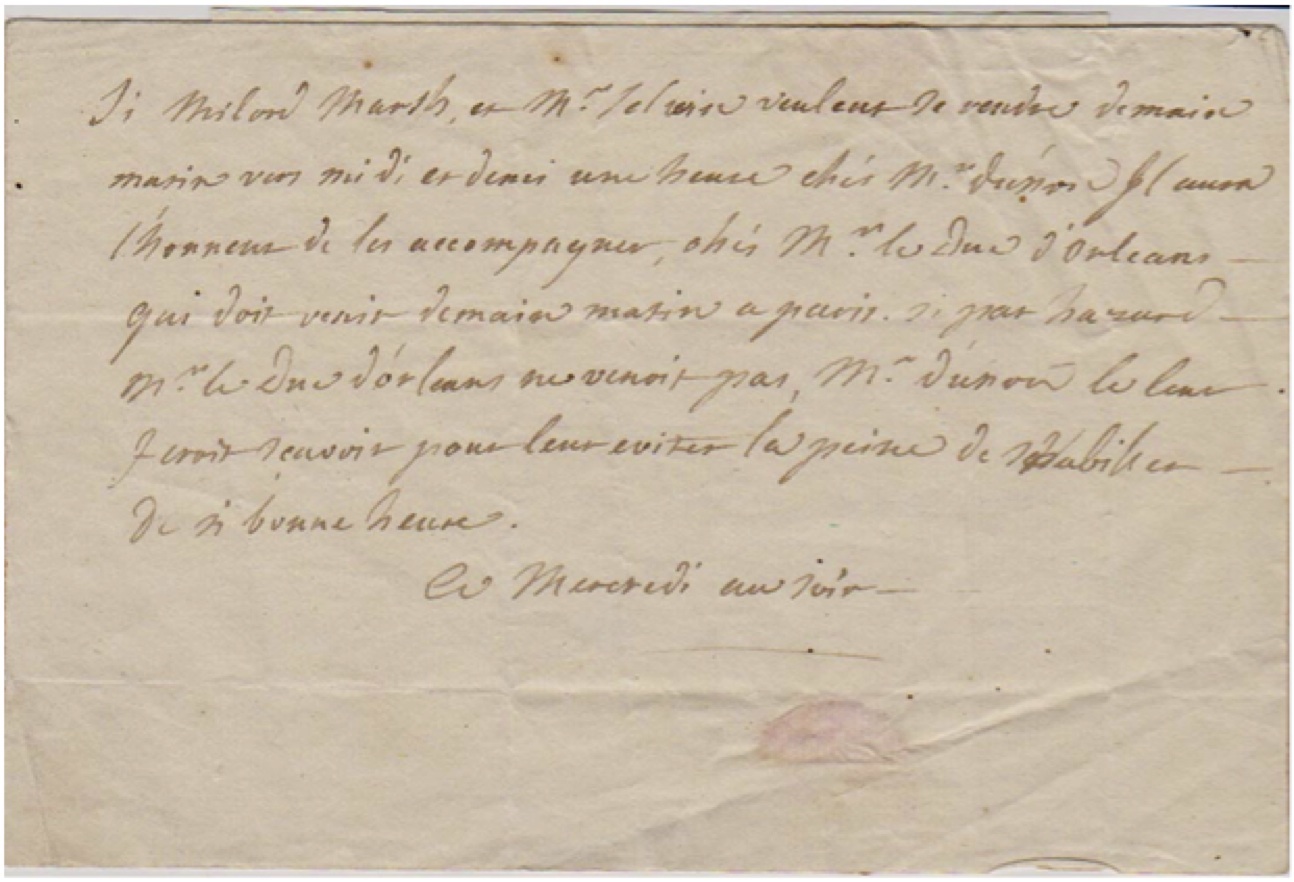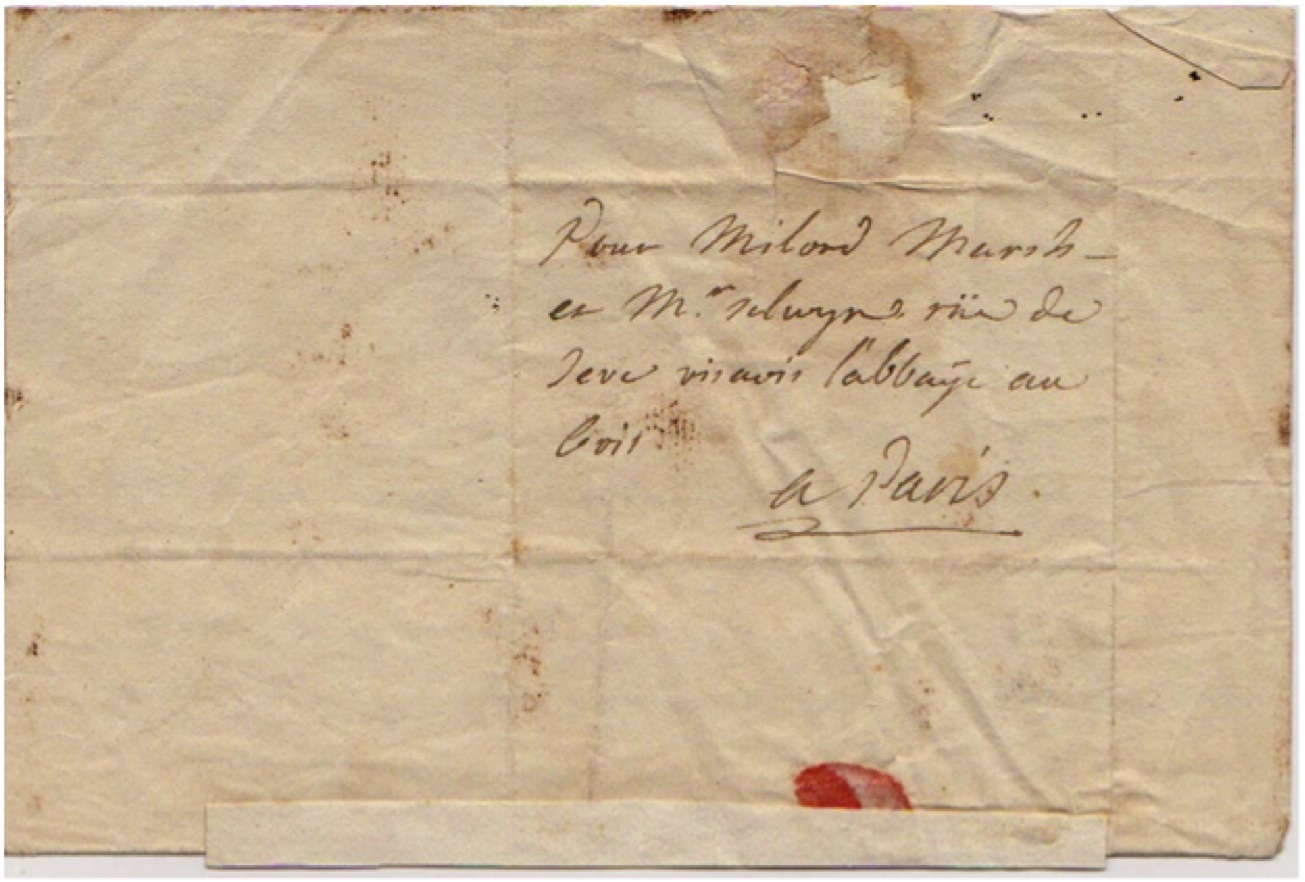

1. From George, 1st Lord Lyttleton.
2. From Rev John ‘Orator’ Henley.
5. From George James (‘Gilly’)Williams..
8. From Madame La Marquise de Stainville.
9. From Charles Townshend, n.d..
15. From Mr. Rogers
Selwyn 14: Letter from Monsieur Dunon
This letter shows the high circle in which Selwyn moved. Although he did not meet the Duc d'Orléans on this occasion, they often attended the same social events and with mutual friends they must have been well acquainted. It is kind of the writer to tell Selwyn if the meeting is not on so that he will not have to rise in time to get there by midday! They were only about half an hour away from St. Cloud where the Duke would have been, which would have meant getting up latest eleven o'clock!
Notes:
Charles Lennox, 2nd Duke of Richmond, 2nd Duke of Lennox, 2nd Duke of Aubigny, KG, KB, PC, FRS (18 May 1701—8 August 1750) was the son of Charles Lennox, 1st Duke of Richmond, and a grandson of King Charles II. Lennox was styled Earl of March from his birth in 1701 as heir to his father's dukedom.[ March entered into an arranged marriage to Lady Sarah Cadogan (1705—1751), daughter of William Cadogan, 1st Earl Cadogan, at the Hague on 4 December 1719 when he was still only 18 and his bride, Lady Sarah Cadogan, was just 13. He held a number of posts in connection with his high office but is best remembered for his patronage of cricket. He has been described as the most important of the sport's early patrons and did much to help its evolution from village cricket to major cricket. Richmond was involved in one of the most controversial matches recorded in the early history of cricket. On 16 August, his Sussex team played a Middlesex XI backed by a Mr Chambers at a venue in Chichester. Mr Chambers' team won this match, which had a prize of 100 guineas, and a return was arranged to take place at Richmond Green on 23 August to be played for 200 guineas. The return match is notable as the earliest match of which the team scores are known: Duke of Richmond 79, Mr Chambers 119; Duke of Richmond 72, Mr Chambers 23–5 (approx.). The game ended promptly at a pre-agreed time although Mr Chambers with "four or five more to have come in" and needing "about 8 to 10 notches" clearly had the upper hand. The end result caused a fracas among the crowd at Richmond Green, who were incensed by the prompt finish because the Duke of Richmond had arrived late and delayed the start of the game. The riot resulted in some of the Sussex players "having the shirts torn off their backs" and it was said "a law suit would commence about the playing." In 1744, Richmond created what is now the world's oldest known scorecard for the match between London and Slindon at the Artillery Ground on 2 June. Slindon won by 55 runs and the original scorecard is now among Richmond's papers in the possession of the West Sussex Records Office.[ Richmond held many titles, including the Order of the Garter (KG), Order of the Bath (KCB), Privy Counsellor (PC) and Fellow of the Royal Society (FRS) on 6 February 1724. He served as Lord of the Bedchamber to King George II from 1727 and, in 1735, he was appointed Master of the Horse. In 1724, he followed his father, the 1st Duke, into freemasonry and was an early Grand Master Mason shortly after the formation of the Premier Grand Lodge of England. His father had been a master mason in Chichester in 1696. As Duke of Aubigny, he also assisted in introducing freemasonry into France. In 1734, he created a masonic lodge in the Chateau d'Aubigny, and a year later, with another past Grand Master, John Theophilus Desaguliers, assisted in inaugurating a lodge in the hotel at Rue Bussy, in Paris. Richmond was one of the founding Governors of London's Foundling Hospital which was a charity dedicated to saving London's abandoned children. Both the Duke and the Duchess took great interest in the project. The Duke attended committee meetings and both took part in the baptism and naming of the first children accepted by the hospital in March 1741. When he died, he was buried in Chichester Cathedral.
Louis Philippe Joseph d'Orléans (13 April 1747 — 6 November 1793) commonly known as Philippe, was a member of a junior branch of the House of Bourbon, the ruling dynasty of France. He actively supported the French Revolution and adopted the name Philippe Égalité, but was nonetheless guillotined during the Reign of Terror. His son Louis-Philippe became King of the French after the July Revolution of 1830. Following his career, the term Orléanist came to be attached to the movement in France that favoured constitutional monarchy.
I can find no specific references to a Mr. Dunan that would tie down to the writer.
 Large image
Large image
The letter reads in translation:
“ If Lord March and Mr Selwyn would care to be at Monsieur Dunan's tomorrow morning at twelve thirty, Monsieur Dunan will have the honour to accompany them to the Duc d'Orléans who is due to arrive in Paris tomorrow. If by chance the Duc d'Orléans does not come, Monsieur Dunan will inform them to avoid them dressing so early.
Wednesday evening. ”
 Large image
Large image